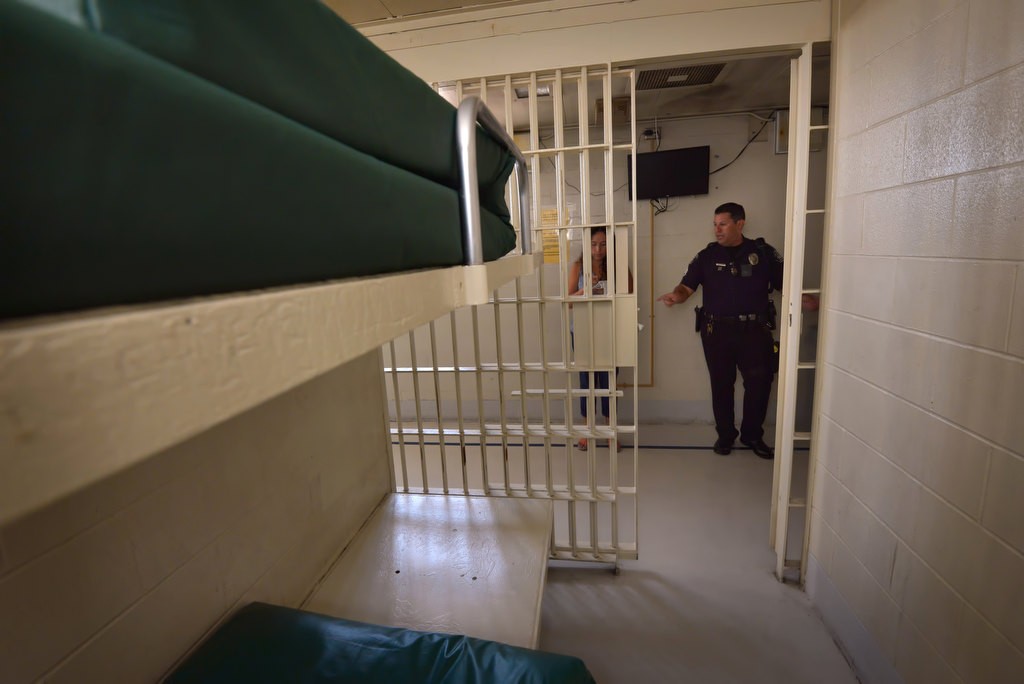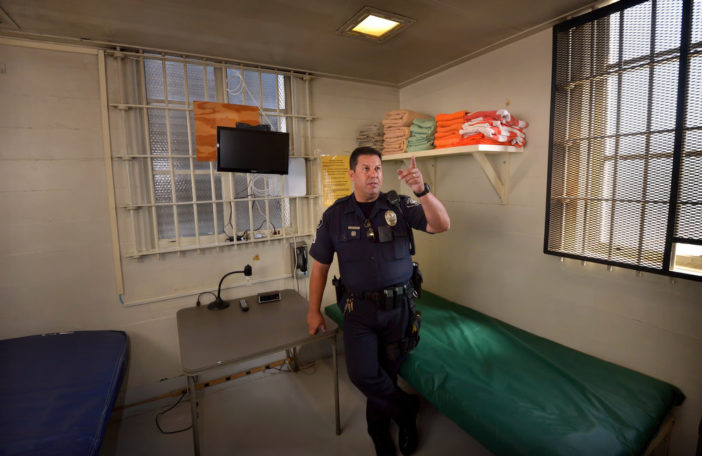The 10-by-12-foot room houses two beds, a small work desk and TV, phone, large fridge, locker space, and board games.
A casual glance into it and a visitor may confuse it with a college dorm room — except for the single toilet in a corner of the room and the bars at the entrance.
No, this isn’t a place most people want to be – but it’s a place they’d rather be, considering the alternative.
It’s called a Pay to Stay, and it’s the Fullerton Police Department’s alternative for non-violent offenders to serve their misdemeanor offenses. There’s a $126 application fee and a $127 day rate.
“It’s small accommodations, but it’s not a regular jail cell,” says Jail Supervisor Sgt. Daniel Castillo.
Nonviolent offenders who’d prefer to pay to stay at FPD’s cell rather than head to county jail must have a court order granting this option. Once the sentence is completed, the FPD jail sends a letter to the judge. The Pay to Stay is open only to men, because the cell is adjacent to the men’s side of the jail and there isn’t one in the women’s section.
While accommodations may be better than the significantly smaller traditional cells – which house one to two beds, a toilet and that’s about it in less than half the size of the Pay to Stay – there’s no question that it’s a jail sentence.
Inmates get one hour of recreation time for exercise outside (which they rarely take, according to Castillo).
“When they’re here, they’re doing light chores,” he says.
Those chores may involve dusting, helping feed other inmates, etc. And when they’re not having their hour of recreation time or doing chores, they are in the room serving their time.

Fullerton PD’s Sgt. Daniel Castillo shows the jail cell used for the Pay to Stay program.
Photo by Steven Georges/Behind the Badge OC
If the judge allows it, inmates can bring work or school coursework (subject to search and seizure) to complete while in the cell. In the case of work furloughs, which a judge may grant, the inmate can go to work between 6 a.m. to 6 p.m. Monday through Friday and return in the evenings, nights and weekends.
Most of the Pay to Stay inmates, Castillo says, are primarily males in their 40s serving DUI sentences – and every now and then, financial crimes offenses. He says the average length of stay is around 30 days – though not necessarily consecutive.
Inmates can bring food from home (subject to search and seizure) and store it in the large refrigerator in the room, which also serves to store other inmates’ provided, refrigerated food.
The room’s phone can be used to place calls collect, and part of the money from those calls is returned to the agency to go into the Inmate Welfare Fund, used to purchase things like TVs (there are also some in the hallway outside the traditional jail cells), board games and books.
Fullerton PD’s Pay to Stay isn’t the only one in the county – Seal Beach, Huntington Beach and Anaheim also have one. Fullerton PD’s cell is the smallest of the four, says Castillo.
Despite Fullerton’s high arrest rate (“We probably have about 5,500 arrests a year – we’re very proactive”), the Pay for Stay isn’t occupied daily.

Fullerton PD’s Sgt. Daniel Castillo shows a normal jail cell at the station. A television can be viewed through the bars.
Photo by Steven Georges/Behind the Badge OC
“I think a lot of people don’t know about it,” he says, adding that when they hear about it it’s because local attorneys inform their clients about the option. “It’s probably occupied on average 10 days out of the month.”
When it is occupied, jailers don’t tend to have many disciplinary problems with the Pay to Stay occupants, according to Castillo.
“I never had to kick someone out mid-sentencing,” he says.
If that did happen, the inmate would go straight to county – which is what the inmate is trying to avoid.
“It motivates them,” Castillo says.
 Behind the Badge
Behind the Badge




